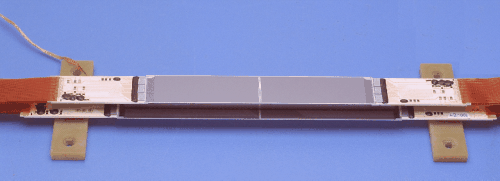
Larger copies of these images in JPEG or GIF format are also available here.
This is an octant of the inner two layers of the CLEO-II Silicon VerteX Detector (SVX). The length of the object shown is about 30 cm, and the typical width is about 3 cm.
The four silicon detectors are visible in the middle of the photo. A carbon fiber beam supports and separates them, and is just barely visible. The electrical connection between the electronics at the ends of the detectors, and the `z' strips is made with a layer of metallization, just visible in the photo, in which readout strips run across the long length of the silicon.
Larger copies of these images in JPEG or GIF format are also available here, as is a hybrid circuit close up in JPEG format.
Electronic hybrid microcircuits are at either end of the silicon. All hybrids are double sided; the hybrid top sides are clearly visible. The substrate of the hybrids is Beryllium Oxide; the white ceramic surface facing upward is visible. Components are visible on the hybrid. In particular, nearest the the detector are the 3 CAMEX integrated circuits. A total of 189 strips on the silicon are wirebonded to the 3 CAMEX circuits; the wirebonds are just visible. Also visible on the hybrid are small rectangular decoupling capacitors, gold traces, and the black `glob top' encapsulant that pots some wirebonds and components.
Flexible circuits made of Kapton are attached at the ends of the hybrids; these carry signals to and from the hybrids. The copper traces on these circuits are visible, as is the clear encapsulant that protects the wirebonds between these traces and the hybrid.
Larger copies of these images in JPEG or GIF format are also available here.
The module is mounted on two greenish supports of G-10.